Overview
The article presents proven strategies for success in healthcare integration, highlighting the critical role of collaboration, advanced technology, and stakeholder engagement. Are you aware of how these elements can transform patient care? Evidence demonstrates that integrated systems lead to improved patient outcomes, enhanced operational efficiency, and significant cost reductions. This underscores the necessity of establishing clear goals and leveraging platforms like Avato’s hybrid connectivity solutions. By streamlining processes, these solutions not only enhance care delivery but also address the challenges faced by healthcare providers. In conclusion, embracing these strategies is essential for any organization aiming to thrive in the evolving healthcare landscape.
Introduction
In an era where healthcare systems are confronted with unprecedented challenges, the integration of diverse services and technologies stands out as a crucial strategy for success. The seamless coordination of clinical, administrative, and financial components is not merely a goal; it is a necessity for enhancing patient care and operational efficiency. As organizations strive to navigate the complexities of modern healthcare delivery, the principles of integration—interoperability, data sharing, and patient-centered approaches—become paramount. Furthermore, with advancements in technology and an increasing emphasis on value-based care, healthcare leaders are recognizing the transformative power of integrated systems.
This article delves into the significance of healthcare integration, exploring its benefits, challenges, and the proven strategies that can pave the way for successful implementation. Through insightful case studies and expert perspectives, it highlights how organizations can leverage integration to improve patient outcomes and enhance operational capabilities in an ever-evolving landscape.
Understanding Healthcare Integration: A Foundation for Success
The integration of various medical services and systems is a critical component of healthcare integration. This process involves coordination and unification aimed at enhancing care for individuals while improving operational efficiency. This unification encompasses clinical, administrative, and financial systems, ensuring that all components function cohesively. Effective collaboration is essential for fostering communication among medical providers, minimizing redundancies, and ultimately enhancing outcomes for individuals.
As we approach 2025, the impact of medical system unification on patient outcomes is increasingly apparent. Organizations prioritizing healthcare integration report significant advancements in care delivery, with studies indicating that integrated systems can achieve a 20% reduction in hospital readmissions. This underscores the importance of embracing key principles of medical coordination, such as interoperability, data sharing, and patient-centered care.
Avato’s Hybrid Connectivity Platform ensures 24/7 availability for essential connections, highlighting the reliability of connection solutions in medical environments. It provides real-time monitoring and alerts on system performance, facilitating seamless and secure data connectivity while significantly reducing costs.
Successful healthcare integration initiatives have yielded tangible benefits. For instance, a notable case study involving a regional health authority demonstrated that by implementing an integrated electronic health record (EHR) system, wait times for individuals decreased by 30%, and overall satisfaction scores improved markedly. Such examples illustrate how strategic unification can revolutionize patient care and operational workflows.
Avato’s Hybrid Connection Platform has garnered praise for streamlining complex linkage projects, delivering outcomes within preferred timelines and budget constraints, thus enhancing operational capabilities in medical services and maximizing the potential of legacy systems.
Healthcare leaders stress the necessity of integration within their organizations. A recent survey revealed that 59% of medical leaders employing generative AI are collaborating with third-party vendors to create tailored solutions. This trend illustrates a growing inclination toward integrated approaches in technology, essential for navigating the complexities of modern medical delivery and ensuring that healthcare integration results in systems that are both efficient and responsive to patient needs.
As Adrià Suazo from the Catalan Health Institute noted, ‘This work has been conducted within the framework of the Doctoral Program in Nursing and Health at Rovira and Virgili University,’ emphasizing the academic backing for unification initiatives.
The principles of healthcare integration are vital for managing these complexities. They emphasize interoperability, enabling different systems to communicate effectively, and a commitment to data-driven decision-making that enhances care quality. By adhering to these principles, medical organizations can establish a robust framework for successful healthcare integration initiatives, ultimately enhancing care for individuals and improving operational efficiency.
Avato’s reliable, future-proof technology stack is essential for adapting to evolving integration demands, ensuring that organizations can future-proof their operations through seamless data and system integration.
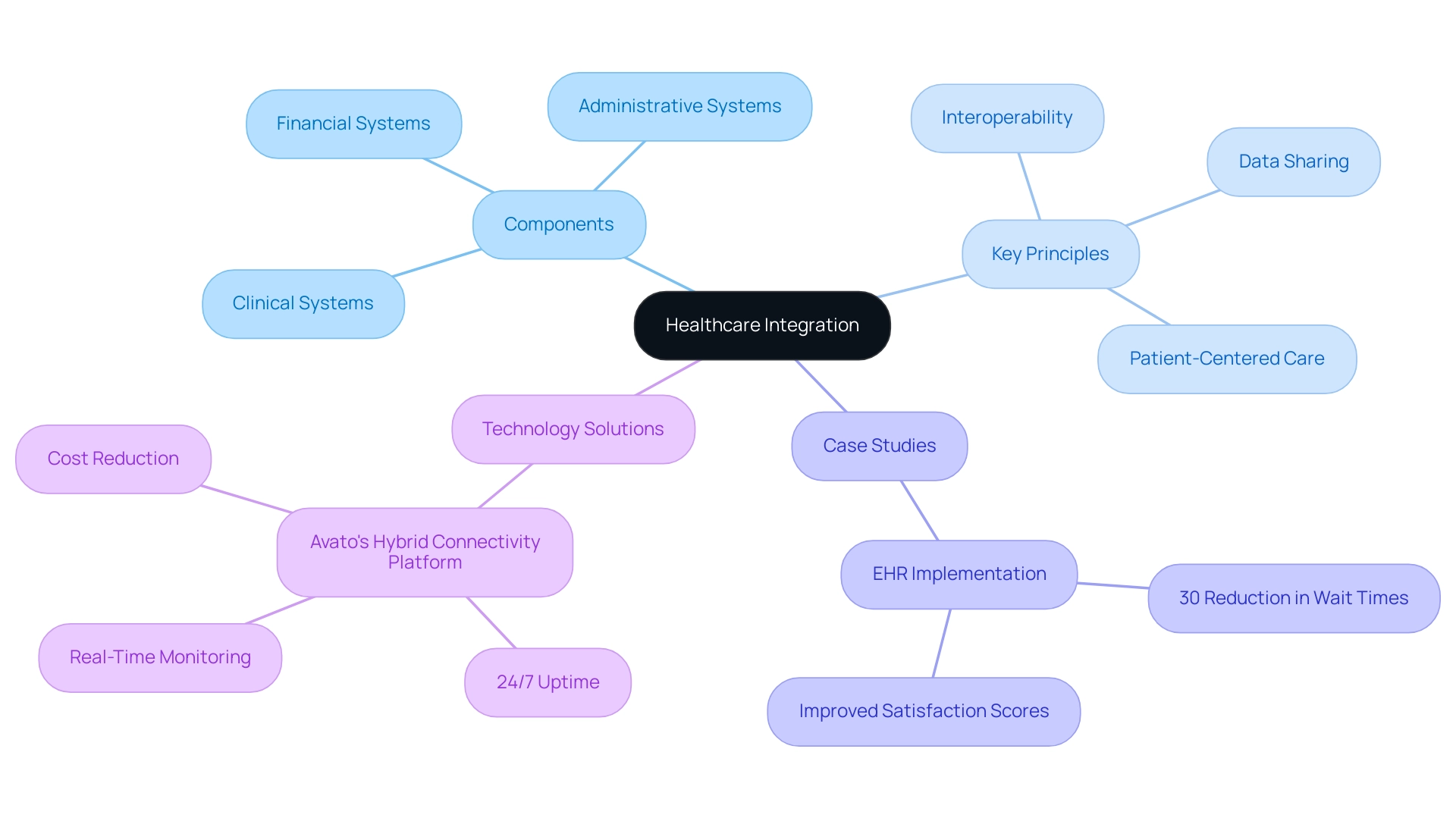
The Benefits of Integrated Healthcare Systems
Healthcare integration through integrated medical systems offers numerous advantages, including improved care coordination, enhanced patient engagement, and increased operational efficiency. By dismantling silos between departments and providers, these systems foster healthcare integration, leading to better communication and collaboration, as well as more comprehensive and timely care delivery. As healthcare executives express optimism about 2025, the shift towards healthcare integration models becomes particularly crucial, necessitating navigation through the complexities of growth, profitability, and affordability of care.
Furthermore, healthcare integration through integrated systems can significantly reduce costs by minimizing duplicate services and optimizing resource allocation. The most recent CAQH Index indicates that fully electronic processing could potentially save the industry $16.4 billion by streamlining high-volume administrative transactions. This financial incentive aligns with the projected growth of the specialty pharmacy segment, which is expected to exceed a 10 percent compound annual growth rate (CAGR) from 2023 to 2028, underscoring the urgent need for efficient integration strategies.
Organizations that have adopted integrated systems for healthcare integration consistently report higher satisfaction scores and improved health outcomes. Testimonials from medical institutions highlight the success of these initiatives, with many noting enhanced client involvement and better overall experiences. For instance, addressing workforce challenges, such as talent shortages and clinician burnout, has emerged as a priority for health systems.
The case study titled “Addressing Workforce Challenges in Health Systems” emphasizes that by focusing on restoring trust among clinicians and leveraging technologies like generative AI, these organizations can enhance operational efficiency and care quality.
As the medical landscape evolves, the emphasis on value-based care and need-based delivery is driving the transformation of legacy care models. Integrated medical systems exemplify healthcare integration, positioning themselves at the forefront of this change and demonstrating their capacity to enhance patient outcomes and satisfaction. Avato’s hybrid unification platform, born from a commitment to tackling intricate challenges, plays a vital role in facilitating these enhancements, allowing medical entities to seamlessly combine their systems and data.
By unlocking isolated resources and improving business value, Avato empowers medical service providers to maximize the advantages of unification. The platform’s capabilities, including support for 12 levels of interface maturity, enable organizations to balance speed and sophistication in their integration efforts. The benefits of healthcare integration in medical systems are not merely theoretical; they are substantiated by real-world success stories that underscore the significance of a unified approach to service delivery.
As Tony Leblanc from the Provincial Health Services Authority remarked, “Avato is a good team, extremely professional and knowledgeable,” reflecting the trust and effectiveness that Avato brings to the healthcare sector.
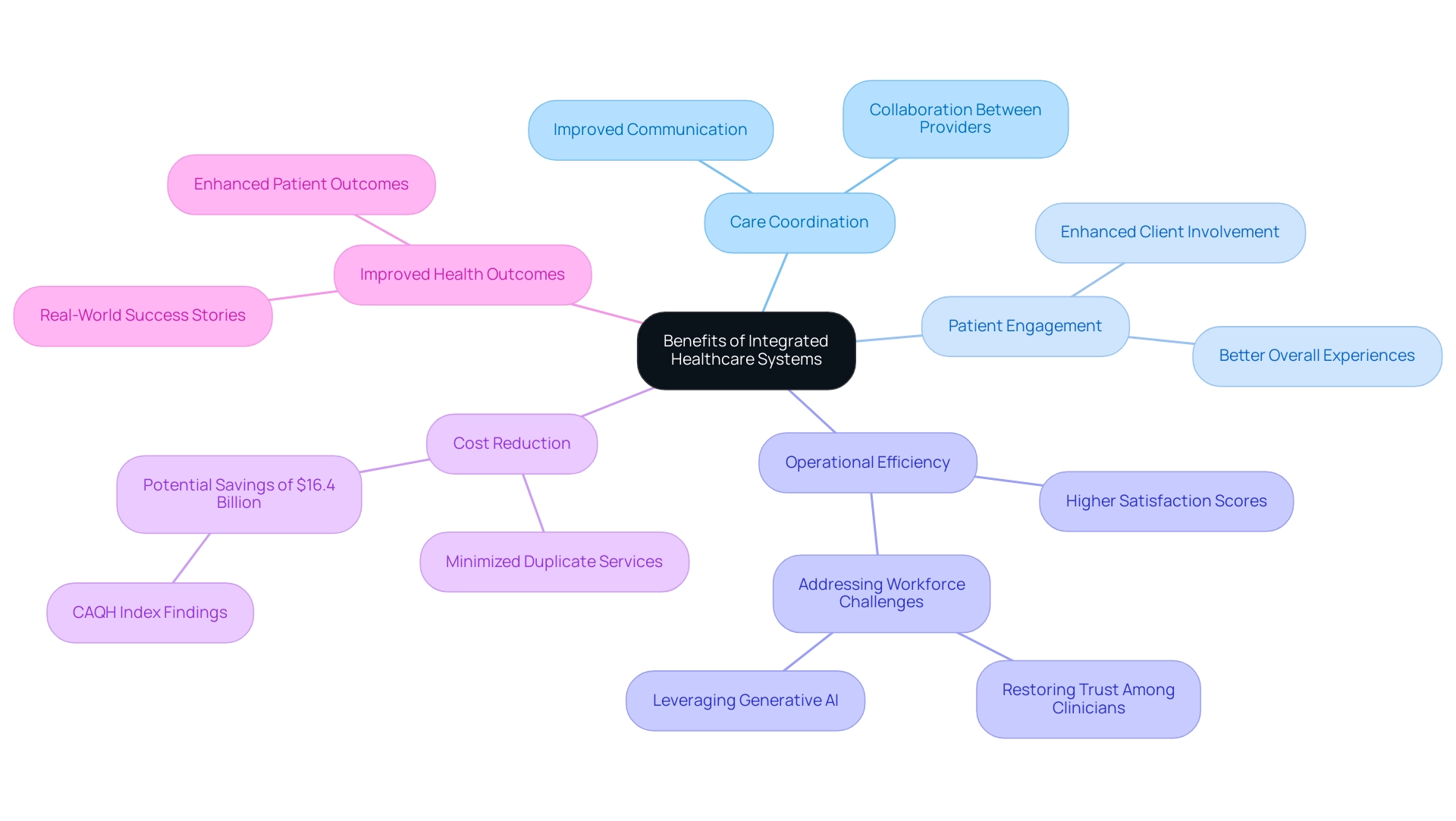
Navigating Challenges in Healthcare Integration
Healthcare integration presents a myriad of challenges that organizations must navigate to achieve successful outcomes. Among the most pressing obstacles are interoperability issues, which arise when disparate systems fail to communicate effectively. This lack of seamless data exchange can hinder patient care and operational efficiency.
Furthermore, resistance to change from staff can impede progress, as employees may be hesitant to adopt new technologies or workflows. The complexity of aligning diverse organizational cultures further complicates unification efforts, often leading to friction during implementation.
In 2025, regulatory compliance and data security concerns remain paramount, with nearly 90% of health system executives acknowledging that the expanding adoption of digital tools and connected care delivery will significantly influence their strategies. This emphasizes the necessity for strong cybersecurity measures as companies modernize their data infrastructure and migrate to cloud environments. Moreover, 46% of health system leaders anticipate climate change to have a moderate effect on their entities this year, suggesting that external factors also contribute to shaping unification strategies.
To tackle these challenges, healthcare entities should prioritize stakeholder involvement in the healthcare integration process, ensuring that all parties are informed and invested in the merging. Mobilizing stakeholders effectively can help gather requirements accurately from the outset, which is crucial for successful incorporation. Investing in comprehensive training programs and implementing change management strategies can facilitate smoother transitions and foster a culture of adaptability within the institution.
Utilizing a gradual method for unification enables entities to tackle problems step by step, reducing interruptions to patient care.
Real-world examples illustrate the effectiveness of these strategies. For instance, health systems that have effectively adopted digital technologies have reported enhanced data unification, which is crucial for maximizing the full advantages of digital transformation. According to the case study titled “Strategies for Implementing Digital Technologies,” modernizing data infrastructure and reinforcing cybersecurity measures are crucial for success.
By focusing on high-quality data integration, organizations can mitigate risks associated with cybersecurity while enhancing operational capabilities.
As medical systems strive to keep pace with changing consumer preferences and expectations, prioritizing equity in technology design and operational investments is crucial. This guarantees that all users have fair access and experience, ultimately leading to improved outcomes. By proactively tackling interoperability challenges and utilizing expert knowledge, healthcare entities can boost their likelihood of successful unification and foster significant advancements through healthcare integration in patient care.
To support these efforts, Avato’s hybrid connection platform provides the necessary tools and technologies for effective process modeling and stakeholder engagement. By employing Avato’s solutions, companies can guarantee a smoother transition and improved alignment with their unification strategies.
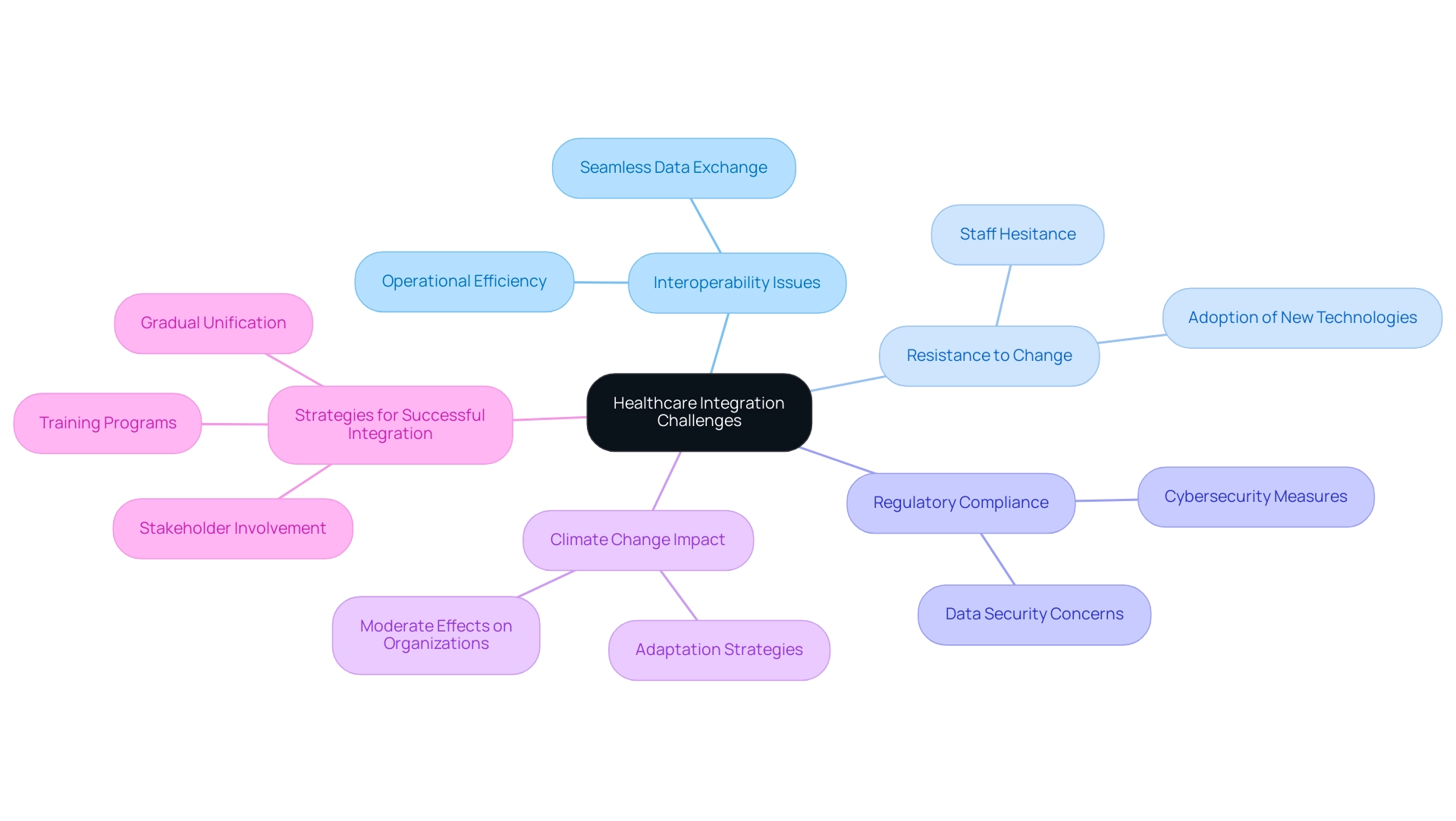
Proven Strategies for Effective Healthcare Integration
To achieve successful healthcare integration, entities must implement established strategies tailored to their specific requirements and objectives. Setting clear goals and objectives is essential; these serve as a roadmap, guiding collaborative efforts and ensuring alignment among all stakeholders. For example, organizations that have effectively integrated Electronic Health Records (EHRs) from various facilities have reported improved care coordination, enabling specialists to access comprehensive patient histories, which fosters informed decision-making and enhances patient outcomes.
A striking statistic reveals that 41 participants (70.7%) were enrolled in urban employee basic medical coverage, highlighting the critical need for health services coordination in urban settings.
Leveraging advanced technologies, such as APIs and cloud-based solutions, represents another pivotal strategy. Avato’s hybrid unification platform, designed to simplify disparate systems, enables seamless data exchange and interoperability, ultimately enhancing healthcare integration and allowing providers to share vital information efficiently. The amalgamation of data from various sources—including EHRs, medical devices, and telemedicine systems—creates a holistic view of individual health, which is indispensable for effective healthcare integration and care delivery.
As TY7 aptly states, “The patient’s medical records should be saved and shared among all community health centers within the same city. It is unacceptable to me that my previous visit information will not be available when I go to another community health center next time.”
Cultivating a culture of collaboration among all stakeholders is equally vital. Engaging healthcare teams, IT specialists, and administrative personnel ensures buy-in and support throughout the merging process. This collaborative approach not only enhances communication but also encourages the sharing of insights and best practices, ultimately leading to more successful healthcare integration outcomes.
Continuous monitoring and assessment of unification initiatives are essential for identifying areas for improvement. Organizations should routinely evaluate their unification strategies against established goals, enabling them to adapt and refine their approaches as necessary. This responsiveness to evolving medical needs and technological advancements is crucial for sustaining success in unification efforts.
In summary, the combination of clear goal-setting, technological leverage through Avato’s hybrid platform, stakeholder collaboration, and ongoing evaluation forms the bedrock of effective strategies for healthcare integration. These elements not only enhance operational efficiency but also significantly improve care and outcomes. A case study on data unification in medical services illustrates that consolidating information from diverse sources, such as EHRs, leads to enhanced care coordination and better patient outcomes, reinforcing the strategies discussed.
Moreover, ensuring that data-driven technologies are accessible to medical team members is essential for maximizing the potential of data in decision-making.
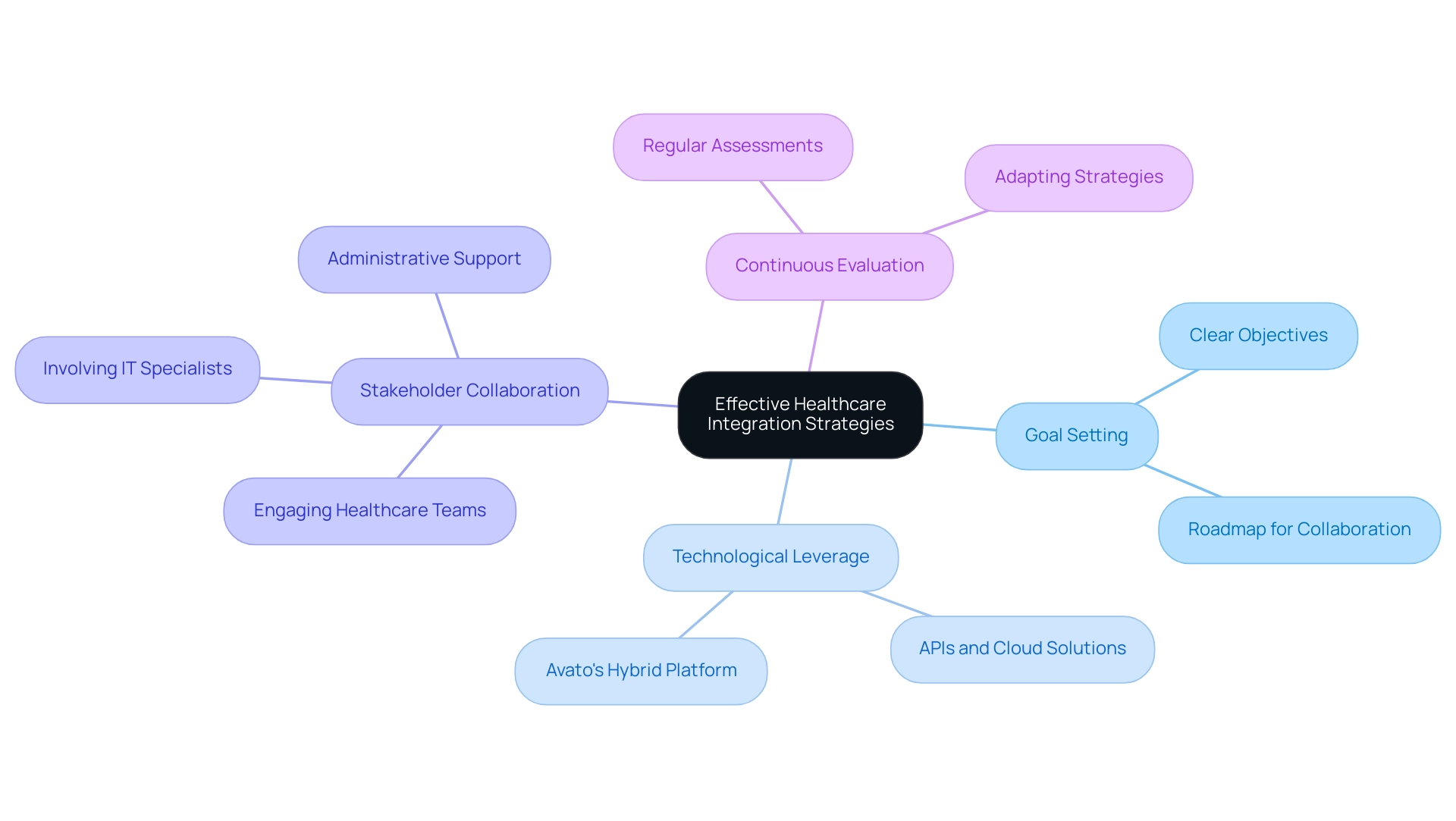
Leveraging Technology for Seamless Integration
Technology stands at the forefront of healthcare integration, facilitating seamless data sharing and communication among diverse systems. Healthcare integration relies on electronic health records (EHRs) and health information exchanges (HIEs) as foundational elements, enabling the efficient flow of information across various medical environments. By 2025, the adoption rates of these technologies are anticipated to increase significantly, with a notable 34% of healthcare entities already utilizing AI applications for diagnostic purposes. This trend showcases the growing reliance on advanced technologies.
Furthermore, 9% of psychiatrists believe that AI could offer empathetic care to patients, highlighting the potential of AI in enhancing patient interactions. Cloud-based platforms further improve collaboration efforts by providing the flexibility and scalability necessary for organizations to adapt to evolving demands. These solutions not only enhance operations but also assist in connecting isolated legacy systems, which is vital in fields like medical services where data accuracy and accessibility are essential. Successful healthcare integration of EHR systems has been linked to improved patient outcomes, as it allows for real-time access to patient data, thereby facilitating informed decision-making.
Insights from industry leaders underscore the transformative impact of technology in medical services. As Slava K., CEO of TATEEDA, notes, “Since the digital shift of the early 2020s, Healthcare IT has really taken center stage. Cloud technology, AI, and big data are now at the core of medical services, changing the game in how we manage care.” This sentiment reflects a broader trend where technology not only enhances operational efficiency but also elevates the quality of patient care.
Case studies emphasize the effectiveness of Avato’s hybrid unification platform in tackling the challenges of medical system connectivity. Clients such as John Johnstone from OSME Pacific and Gustavo Estrada from BC Provincial Health Services Authority have commended Avato for streamlining complicated projects and achieving outcomes within strict timelines and budget limitations. Their testimonials demonstrate how Avato’s distinct abilities in reducing risks linked to digital transformation have aided medical entities in reaching their unification objectives rapidly and efficiently.
Avato, which derives its name from the Hungarian word for ‘of dedication,’ embodies a commitment to solving complex unification challenges. By utilizing advanced technologies like EHRs, HIEs, and cloud-based solutions, medical organizations can improve healthcare integration strategies. Avato’s dedicated hybrid unification platform not only streamlines these processes but also specifically meets the requirements of Banking IT Managers, ensuring that they can enhance care for individuals and operational efficiency, positioning themselves for success in an increasingly digital landscape.
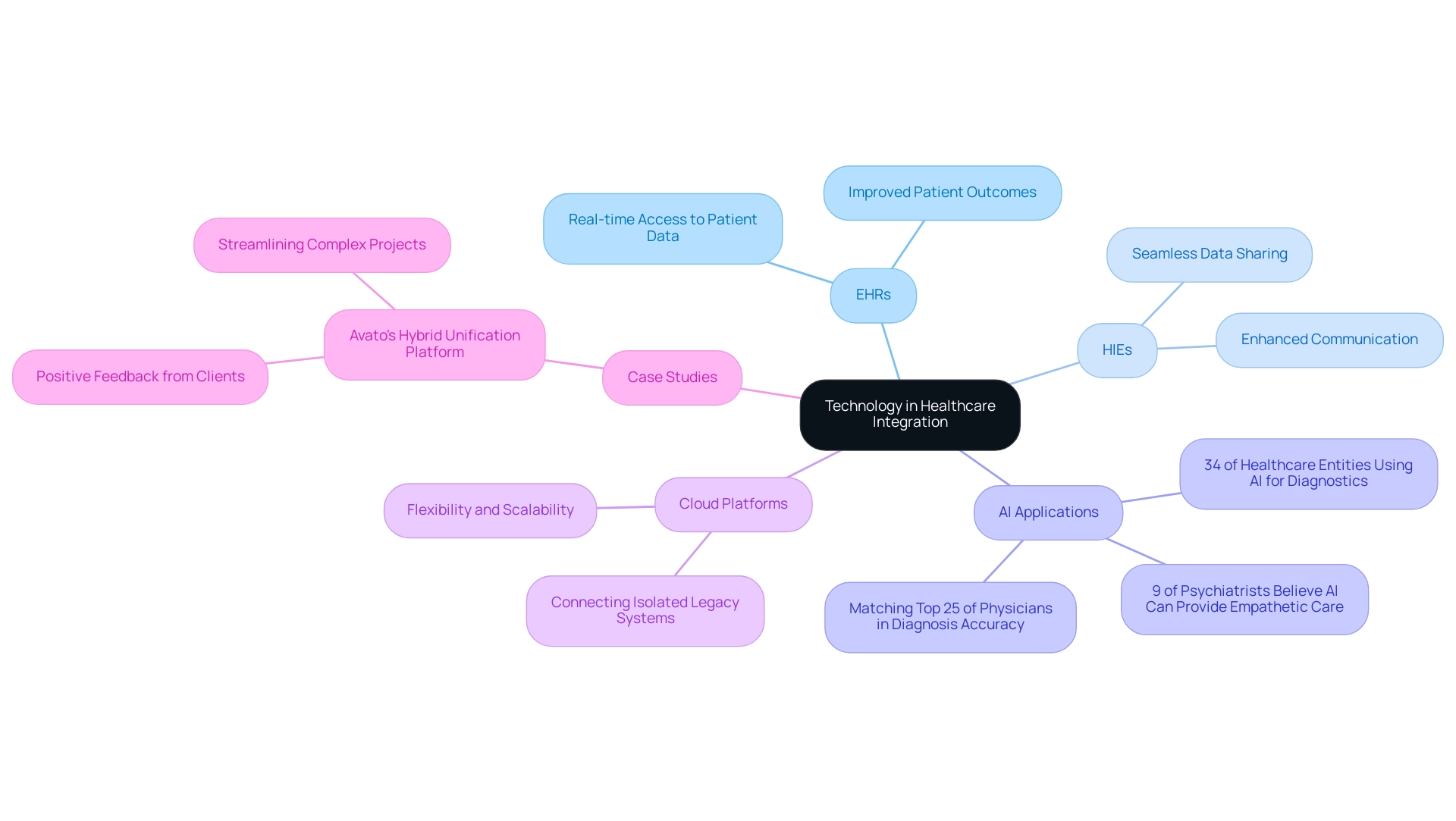
Engaging Stakeholders: The Key to Successful Integration
Involving stakeholders is crucial for the success of integration initiatives in the medical field. This engagement extends beyond medical providers to include patients, administrative staff, and external partners. Establishing clear communication channels is essential; entities should actively involve stakeholders in the planning and decision-making processes.
Regular updates and feedback sessions not only uphold transparency but also nurture trust among all parties involved. The importance of effective communication in healthcare collaboration cannot be overstated. Research shows that entities that emphasize stakeholder involvement experience better results in their unification efforts. For instance, a recent study on stakeholder engagement in health research highlights the necessity of clarifying roles and expectations, fostering authentic partnerships, and adapting to the interests of diverse stakeholders.
These strategies result in improved effects in health research, which can be directly applied to unification initiatives. As T4 indicates, it is essential to cultivate early guidance from available evidence to steer these efforts. In 2025, the environment of stakeholder involvement in healthcare integration continues to change, with statistics demonstrating that organizations utilizing strong communication strategies are more likely to achieve their healthcare integration objectives.
Successful examples include initiatives where medical leaders have emphasized the importance of ongoing dialogue and collaboration, resulting in streamlined processes and better patient outcomes. Furthermore, Avato ensures 24/7 uptime for critical connections, underscoring the importance of dependable linking in the context of stakeholder engagement. Avato’s hybrid connection platform is crafted to simplify complex linkages, making it a dedicated solution for enhancing business value in banking, medical services, and government sectors.
Moreover, the incorporation of stakeholder feedback into project development has proven to be a game-changer. By fostering a collaborative atmosphere, companies can significantly improve the effectiveness of their unification efforts, ensuring that the needs and concerns of all stakeholders are addressed. This method not only results in successful unification but also prepares organizations to adjust to future challenges in the healthcare landscape.
However, it is important to note that the findings from the study may not be generalizable to all primary health care research due to specific project priorities and contexts. Additionally, Avato differentiates itself from competitors by providing speed, security, and simplicity in combining systems, which are enhanced through effective stakeholder engagement. As Tony Leblanc from the Provincial Health Services Authority states, ‘Good team. Good people to work with. Extremely professional. Extremely knowledgeable.’ This testimonial demonstrates Avato’s dedication to providing exceptional solutions that meet the needs of their clients.
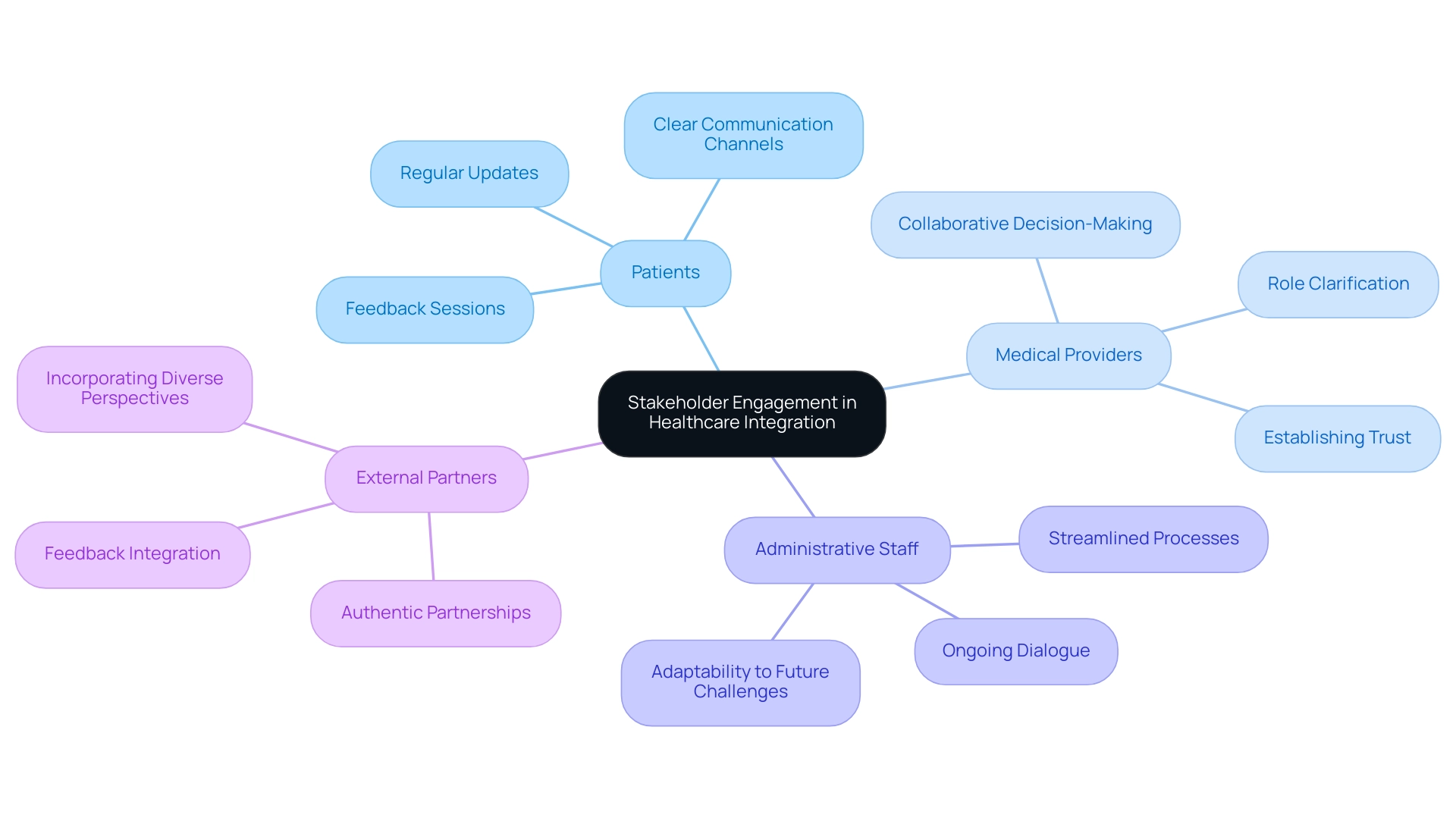
Case Studies: Success Stories in Healthcare Integration
Numerous medical organizations have successfully implemented unification strategies, leading to significant improvements in care quality and operational efficiency through healthcare integration. For example, a prominent hospital system that integrated its Electronic Health Records (EHR) with telehealth services witnessed an impressive 30% increase in patient engagement, coupled with a marked decline in appointment no-shows. This integration not only facilitated better access to care for individuals but also streamlined communication among healthcare providers, ultimately enhancing healthcare integration for patients receiving treatment.
In another compelling case, a community health center utilized Avato’s hybrid unification platform to overhaul its referral process. This initiative expedited patient access to specialty care, illustrating how effective healthcare integration can eliminate service delivery bottlenecks. Avato’s platform specifically addresses the challenges posed by disparate systems, ensuring seamless data flow and improved operational efficiency—crucial elements for medical institutions.
Moreover, data gathered from 11 quarterly meetings of the Case Management Program (CMP) committee across six hospitals highlighted a strong consensus among participants regarding the necessity of healthcare integration, enhanced communication, continuity of care, and accessibility in medical services. These insights underscore the vital role that healthcare integration plays in tackling the challenges faced by medical institutions today. As Gustavo Estrada aptly stated, “Avato has the ability to simplify complex projects and deliver results within desired time frames and budget constraints,” a critical capability for organizations navigating these complexities.
As medical services continue to evolve, the integration of systems and processes will remain fundamental to improving patient care and operational efficiency, fostering a more connected and responsive healthcare environment. Arvato distinguishes itself in the marketplace by offering speed, security, and ease of implementation, aligning seamlessly with the needs of medical organizations in search of effective solutions. Furthermore, the case study titled “Evolution of Case Management Program Leadership” illustrates how successful healthcare integration can enhance resource distribution and reduce the number of frequent emergency department users, further emphasizing the transformative impact of healthcare integration on medical services.
For banking IT managers, Avato’s solutions provide a strategic advantage by ensuring that medical systems operate effectively and securely, ultimately enhancing the overall user experience.
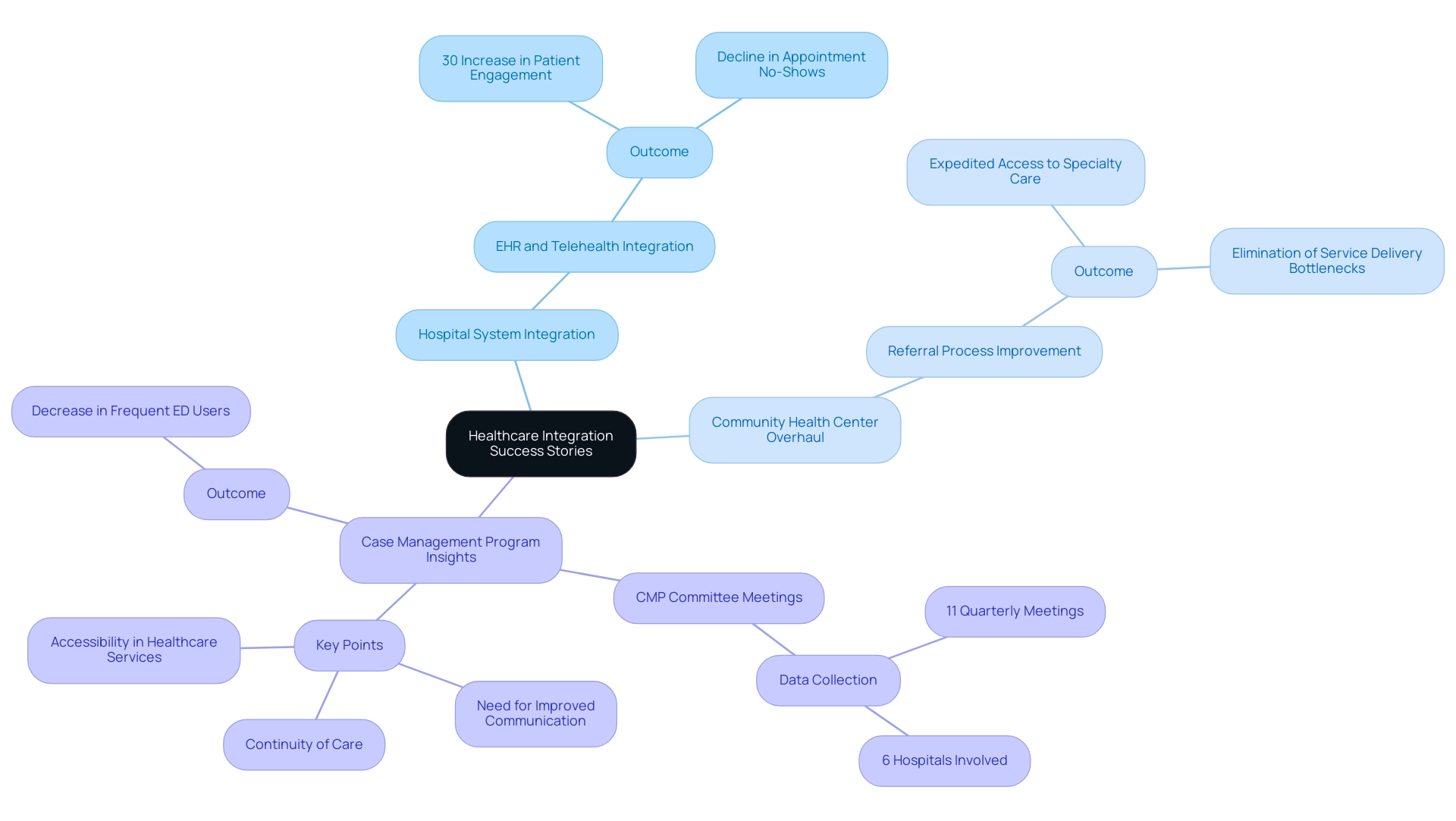
Future Trends in Healthcare Integration: Preparing for Change
The medical field is undergoing significant transformation, with several key trends poised to shape the future of unification. The surge in telehealth and remote monitoring creates an urgent demand for robust unification solutions that can manage diverse data sources, facilitating healthcare integration. This evolution not only enhances accessibility but also necessitates seamless connectivity among various medical systems to ensure comprehensive care for patients.
Moreover, the growing emphasis on patient-centered care is driving organizations to implement holistic strategies for healthcare integration that prioritize the overall experience of care recipients. This approach involves integrating financial transparency with technology to streamline processes, ultimately boosting satisfaction and outcomes. Effective strategies for improving the patient financial experience encompass increased price transparency and a consolidated view of medical services.
Looking ahead to 2025, advancements in artificial intelligence and machine learning are anticipated to revolutionize data analytics capabilities within healthcare organizations. These technologies will empower decision-makers to derive actionable insights from integrated data, enabling more informed strategies that align with evolving medical needs. Notably, nearly 90% of health system leaders expect that healthcare integration, propelled by the rising use of digital tools and connected care delivery, will influence their strategies in 2025, underscoring the critical role of unification in future medical models.
Case studies, such as those from the specialty pharmacy sector, illustrate the dynamic landscape of medical unification. The specialty pharmacy segment is rapidly growing, fueled by increased therapy utilization, while retail pharmacies encounter margin pressures from declining reimbursements. This scenario highlights the necessity for adaptable incorporation models that can respond to shifting consumer demands and reimbursement frameworks.
Avato’s dedicated hybrid unification platform exemplifies this adaptability, providing unparalleled value through speed, security, and simplicity—essential attributes for navigating the complexities of medical system connectivity. For instance, Avato has effectively enabled medical organizations to integrate diverse systems, resulting in enhanced operational efficiency and improved patient care outcomes.
By staying attuned to these trends and employing innovative connection strategies, medical organizations can position themselves for success in an increasingly complex environment, ensuring their unification efforts remain effective and aligned with future demands. Avato’s commitment to building technology foundations empowers businesses to future-proof their operations through seamless data and system integration, ultimately transforming healthcare with digital medicine and enhancing data accessibility through healthcare integration.

Conclusion
The integration of healthcare systems is not merely a strategy; it is a vital necessity for the future of patient care and operational efficiency. Effective healthcare integration encompasses the coordination of clinical, administrative, and financial components, leading to improved patient outcomes and reduced costs. The case studies presented demonstrate that organizations implementing integrated systems have witnessed significant enhancements, from decreased hospital readmissions to increased patient engagement and satisfaction.
However, the journey toward successful healthcare integration is fraught with challenges, such as interoperability issues and resistance to change. Addressing these obstacles through stakeholder engagement, comprehensive training, and strategic planning is essential. Leveraging advanced technologies, such as Avato’s hybrid integration platform, showcases the potential for overcoming these hurdles and achieving seamless data sharing and communication among diverse healthcare systems.
Looking ahead, trends shaping the future of healthcare integration—such as the rise of telehealth, patient-centered care, and the integration of artificial intelligence—underscore the need for organizations to adapt and innovate continually. By embracing these changes and prioritizing integration, healthcare organizations can enhance their operational capabilities and improve the quality of care provided to patients.
In conclusion, the imperative for integrated healthcare systems is clear. Organizations that prioritize integration not only position themselves for success in a rapidly evolving landscape but also ensure that they can deliver high-quality, patient-centered care. With the right strategies and technologies in place, the future of healthcare integration promises to transform the way care is delivered, ultimately benefiting patients and providers alike.

